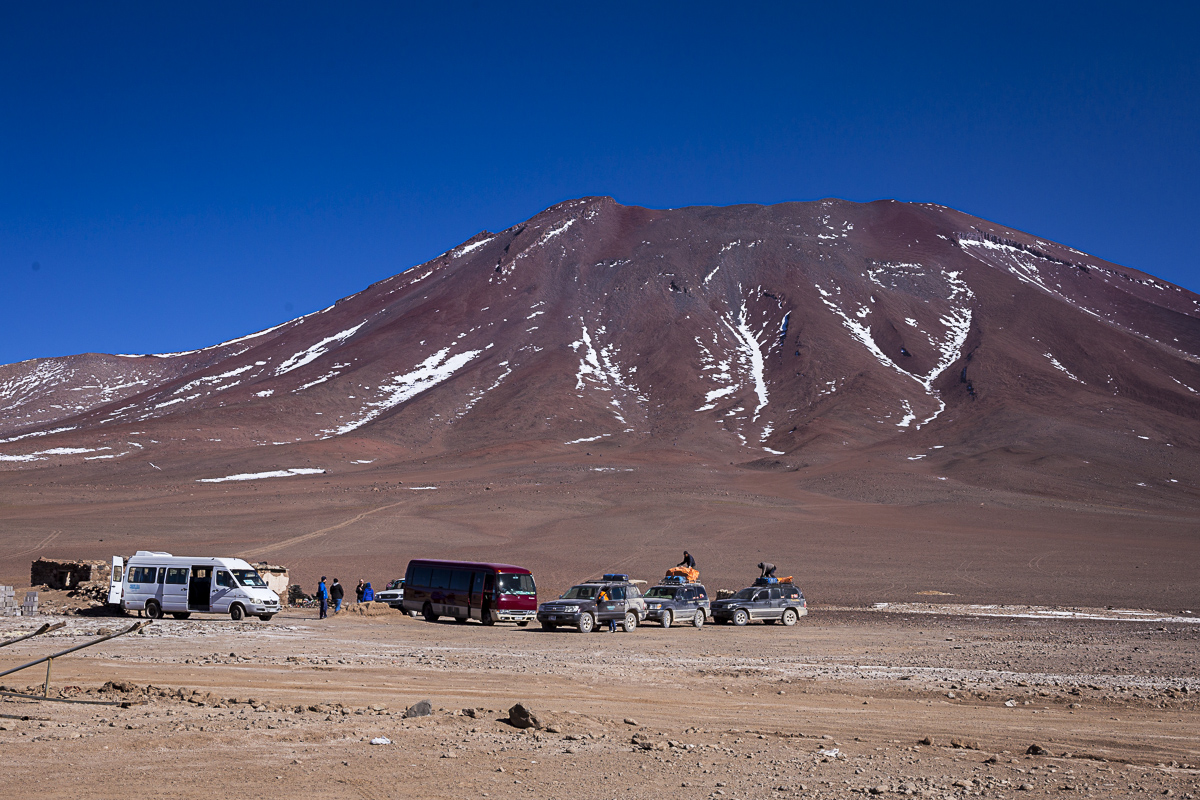After the easy yet full of scams border crossing of Kasani here we are, the time has come to leave Bolivia and start our adventure to Chile. Once again, crossing into Chile might seem hard (many regulations, strict police officers) but it really is a piece of bread.
Similarly to when we crossed into Peru from Ecuador, this time will also opted from entering Chile at a very little known (yet touristy) Hito Cajon. This outpost, isolated up in the Andes, is made up of nothing but tiny offices which receive all those tourists wishing to cross into Chile after having taken a 3-day tour (or more) from Uyuni.
How to get there
If you’re planning to get to Hito Cajon on your own from Uyuni, then you’ve gotta change your plan. In fact, even though crossing here it’s a convenient option to visit San Pedro de Atacama straight after Uyuni (or vice versa), only tourist cars e.g. 4×4 off-roads manage to get here from the bolivian side.
Given the vicinity to many famous hotspots such as the Laguna Verde and Sol de Mañana Geysers, whenever you decide to book a minimum of a 3-day tour from Uyuni, tour companies will usually ask you whether you want your tour to end in Chile. If that would be your case, on the last day of the tour you’ll be driven to the border by the tour guide and transport will be arranged for you to get to San Pedro de Atacama.
Currently, there are no buses that cross at this border. If you want to cross into Chile using public transport, you’ll have to get a direct bus from Uyuni to Calama which will cross the border at Ollagüe. All aside, the best strategy to get to Chile is to book a tour beforehand that includes the onward transport usually Calama/Atacama.

Border fees & taxes
Contrairly to what all tour agencies and border patrols will tell you, there are no taxes or fees to pay for you to either enter or exit both countries (except US citizens who require a paid Visa to enter the country). As we already mentioned in our Ultimate Guide to Book a tour in Uyuni, there’s a high chance that when exiting Bolivia you’ll be asked for a 15Bs. “fake” exit fee but make sure you refuse to pay it cause it’s completely illegal.
That said, remember a little green ticket you were given upon entering Bolivia? Well, if you loose that then upon exiting the country you’ll have to pay 70Bs. as a fine and have to fill out another immigration document that you’ll be given on the spot. Not a nice way to end your trip, uh!
Transport to Chile
If you read our Ultimate Guide to Book a tour in Uyuni, you should know that before booking a tour you should have asked whether your transport to Chile was or wasn’t included in the price. This should be the case, then once at the border you’ll only have to worry onto which white van your luggages are going on.
In case your transport was not included, then it’s a different story. Unfortunately, from the Chilean side all the vans that take tourists to San Pedro de Atacama are operated privately by tour companies. This is the backpacker hell cause you can’t haggle the price down, get a better deal or wait for cars to fill up to get discounted rates: the price will not change.
Currently, a one-way fare to San Pedro de Atacama from the border of Hito Cajon (bolivian side) it’s worth the beauty of 70Bs. (10$, 8.5€) for a short 1-h ride. Make sure that your tour drops you off at the border of Hito Cajon at around 9-10am (if you don’t have an onward journey already booked with the tour) cause otherwise you’ll hardly find any transport to Chile!
 The small border office
The small border office
Crossing at Hito Cajon vs. Ollagüe
Now you might be wondering what’s the best option for you, whether crossing at Hito Cajon is better than Ollague or vice versa. Here’s a quick comparison:
After Uyuni you plan to enter Chile: If this is the case then you should definitely opt for finishing your tour in Chile and cross the border of Hito Cajon. Whether you want to finish in Chile or not, the tour will always bring you back to Uyuni but the 7h drive back to Uyuni + taking the bus to Calama (via Ollagüe) will end up being a more expensive and tiring option. Cross at Hito Cajon!
After Uyuni you plan to keep staying in Bolivia and/or visit Calama: If this the case then you should definitely opt for getting back to Uyuni and keep travelling from there. Uyuni is a good center for buses heading to Sucre, Potosi and La Paz. Alternatively, there are also daily buses (cheap rates) connecting Uyuni with Calama. Cross at Ollagüe!
PLANNING A TRIP TO BOLIVIA? CHECK MORE GUIDES BELOW!
[pt_view id=”b971836r98″]

hello, i was looking for a transfer from hito cajon to my hotel in san pedro de atacama.
currently,most operators are quoting me 150 usd++.it would be very helpful if you could tell me the cheapest possible way to transfer from hito cajon border to SPDA
Hey There! Thanks for stopping by 🙂 As mentioned in the article, it’s pretty common to arrange transport from Hito Cajon to San Pedro from Uyuni, in fact most tours will ask you if where’s your final destination. Nonetheless, once in Hito Cajon there are several vans that offer that service since most of them often go to San Pedro half-empty. You can get a seat for 10-15€ to the town center of San Pedro and once there finding your hotel will super easy. Hope this helps!!!
P.s. ( Don’t trust people quoting you 150$ for that, its stupidly expensive, maybe they’re already including the Uyuni Tour?)
Thanks for really useful article, on the 150 USD transfer price (from Hiro to San Pedro) we ended up having to pay this as it wasn’t included in our tour and we got to the border at 2pm, if you get there at 9-10am there are lots of available cabs with space (because they’ve dropped people for the start of their Bolivia tours) – however at 2pm there was no one! So they have to arrange a private transfer.
Although it was expensive we then didn’t have to rush our last day (the tour operator gave us the alternative of starting at 5am to get to border for 10am) – also at the Chile border we were the only vehicle so turn around time was super quick
Basically a check with the tour before booking would have saved us the extra cost/hassle but hopefully this will help others 🙂
Very glad you found the article useful! Sorry to hear of the hefty fee they made you pay. Yeah usually the tour companies plan it well with the van drivers on the other side so that they can drive tourists to Atacama or Calama at around that time. Thanks a lot for sharing your experience there 🙂 I’ve made a note on the article to make it clearer! I hope you guys enjoyed that part of the world as much as I did! Good luck with your travels!
Hi, why it’s not possible to enter in Chile from the Hito Cajon border with a car rented in La Paz?
Hi Andrea! Crossing the Hito Cajon border with a car rented in La Paz can be a hard thing. First you’ll need the car company permits (insurance) to cross over, then the car will have to be at least a 4×4 cause the road to get there is not easy and last but not least, you’ll have to know where you’re going. In that area you won’t find a single roadsign so only if you’re already know the place can orient yourself. Again, it’s not “impossible” but very very hard and full possible issues that you could simply avoid by taking a tour.
If I want to go to Uyuni from Atacama, may I apply Bolivia visa at the border of Hito Cajon? How much I have to pay for the visa?
Thanks.
Hi Doris! Thanks for stopping by! As far as we know, at the Hito Cajon border they will issue you a bolivian visa. For all nationalities, you’re not supposed to pay anything for either entering or exiting a border (visa is free) BUT the officers at this specific border crossing will try to charge you something. When we crossed, we simply said we were not going to pay and they simply let us through. Just be aware this “illegal” policy is present and then decide for whatever you feel more comfortable with, even though we would suggest you to do everything you can to avoid supporting this!
Hope you find this helpful!
It sounds like a long process and a handful. Good thing I’ve seen this post so when I get to travel to Chile I know what to do. It is a little challenging but super informative.
Thanks for stopping by Katya! Glad you found it useful, let us know when you travel to Chile if you need more info!